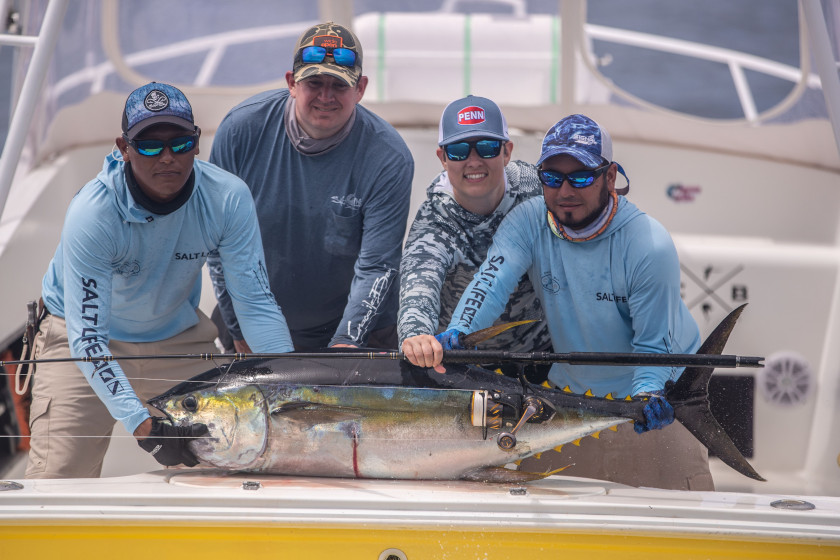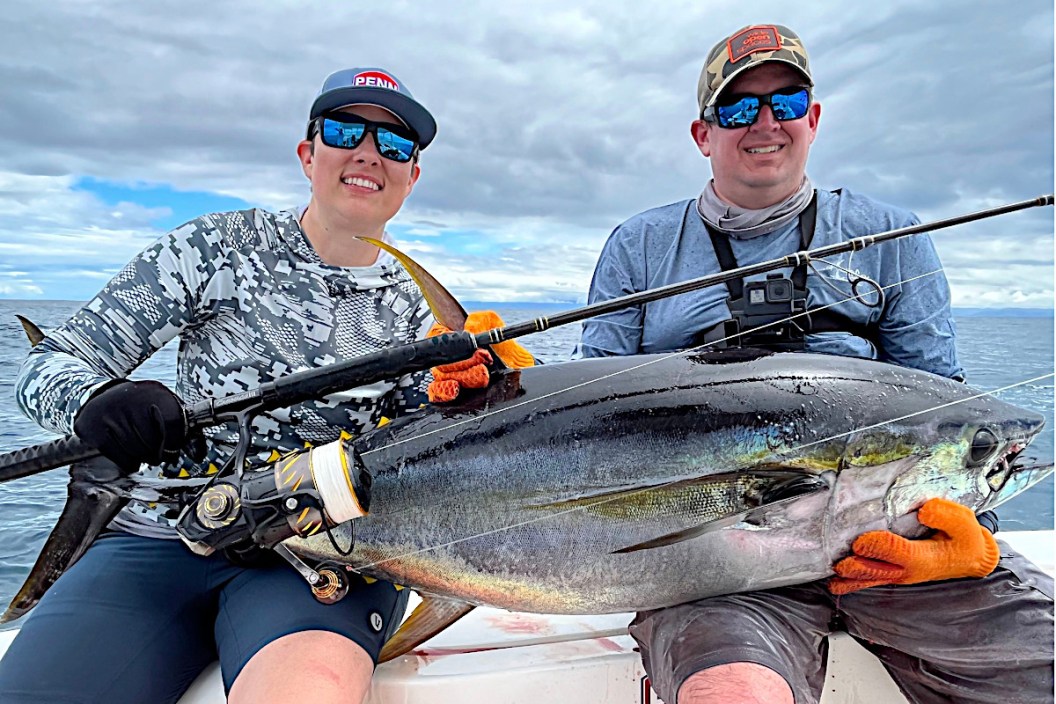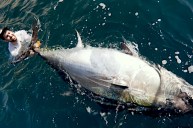We got our first look at the big yellowfin tuna approximately 20 minutes after it first took our bait when we were about 40 miles off the Pacific coast of Costa Rica. Around this same moment, the tuna realized it was hooked for the first time. Before I could react, the fish made a hard, driving run for the depths in a slow circle. The PENN spinning reel started screaming as line flew off of it. We wouldn't see the tuna again for another 30 minutes. When we finally got the fish out of the open ocean and onboard, it measured 60 inches long and weighed 91 pounds on the dock scales. I would have thought it was over 100 pounds, because that fish spent about four to five hours in the boat's cooler before the official weigh-in happened. It boggled my mind to think this fish was still hundreds of pounds off the all-tackle world record!
I had always heard about the yellowfin's legendary fighting ability, but this was my first time experiencing it firsthand. After tangling with a few other, albeit smaller, specimens the next day, I flew home with a newfound respect for this tuna species. In addition to being easy to find and catch, the yellowfin is one of the best eating fish in any ocean ecosystem. This is everything you ever needed to know about pursuing this popular species.
What's So Special About Yellowfin Tuna?

Ben Martin
Some anglers may wonder why one should even bother with yellowfins when bigeye tuna and bluefin tuna grow to much larger sizes overall. Well, for one, yellowfins have one of the largest ranges of any tuna species out there. They can literally be caught all over the world. The fisheries for yellowfin are also a bit more robust than some of the other subspecies out there. Bigeyes and bluefins have started to feel the strain of overfishing by the commercial fishery industry in recent years.
Thunnus albacares, as yellowfins are scientifically known, has one of the shortest life spans of all tuna species. Despite the huge sizes, most only live six to seven years at most. So, there's a little less guilt over harvesting a large fish like there might be with a bluefin, which could be 25 to 30 years old on the high end. For the sustainability and conservation-minded angler, there are simply more yellowfin to go around if you're harvesting with intent to consume. The International Union for Conservation of Nature (IUCN) has yellowfins listed as a species of least concern, even though they are targeted heavily by the commercial industry.
At the same time, yellowfins grow significantly larger than a skipjack. They also provide a significant amount of fight even at smaller sizes. The day after we landed that 91-pounder, our guides put our boat onto a giant school of 40- to 50-pound Pacific yellowfin tuna that kept us entertained for hours. It's also simply a gorgeous fish. Depending on where you catch them, these fish are mostly dark blue but display bright yellow highlights on their body, tail, dorsal fin, and anal fins. There is often an iridescent stripe running the length of the fish, and some of the smaller specimens may also have a series of vertical stripes and white dots.
Fishing for Yellowfin Tuna

Adrian Gray/IGFA
Because yellowfins are a highly migratory species, there may be times of the year that are better than others for finding them depending on the area you're fishing. In some places you can catch them year-round, but summer and fall tend to be the best times for others, especially in the United States. In more tropical areas like Hawaii, the tuna fishery can produce good numbers year-round.
Probably the single most widely-used method for fishing yellowfins is to find dolphins or whales first. These mammals usually feed on the same types of baitfish as the tuna, and they often move together. This caused issues in the past with purse seine commercial netters killing lots of dolphins and whales in their bycatch. Fortunately, new regulations and better fisheries management have eliminated most of that. Still, finding the feeding dolphins and whales remains an effective method of locating big schools. Just watch for the circling birds as your first indication. In fact, birds can be a great indicator of tuna even where no whales or dolphins are present. If you're still having trouble locating them, try trolling a spreader bar or kite fishing as search tactics.
The good news is yellowfins can be caught using a variety of methods. They feed mostly on baitfish like mackerel and crustaceans like crabs; they can also be caught on squid. If you can find a feeding school, it's often as simple as getting ahead of the school and tossing a properly baited presentation in their path. However, there is something to be said for taking advantage of this schooling behavior to toss a large topwater popper. There's nothing quite like watching a big yellowfin blow up your lure on the surface.
One thing is for certain, once you're on the tuna, the action can be fast and furious, especially if you're chumming or "tuna chunking." If you're going for numbers, we recommend using conventional reels since they do offer a slightly easier fight. If you want a real challenge, try using lighter spinning tackle or even fly gear. Tunas rarely jump while hooked. They mostly just make hard, deep runs. The body of a tuna seems like it's made of pure muscle, so you'll want a relatively stiff rod action too. It depends on how much of a fight you want. Down in Costa Rica we were using the new PENN Authority spinning reels on their Carnage III rods when we hooked into that near-100-pounder. Spinning tackle is the way to go if you're looking for a fight, while conventional rods and reels like the new PENN Fathom II reel and Ally rods offer more backbone and strength for bringing tuna to the boat quickly. The PENN International and Shimano Tiagra are also solid choices for tuna reels.
For line, most anglers like to use either braid or fluorocarbon with a slight preference for the former because of the way tuna like to run. Line classes up to 40 or 50 pounds will work for smaller tuna, but look into spooling 80- to 120-pound line if you're going after larger yellowfins.
Cooking and Eating Yellowfin Tuna

Adrian Gray/IGFA
The other reason yellowfins are so popular is because it's one of the best eating fish on the planet. The huge commercial markets for this species back that up, even if we're starting to see reductions in netting and longline efforts in both the Atlantic and Pacific Oceans. Tunas produce a mild meat that is suitable for many types of dishes. In many parts of the world, tuna is made into both sushi and sashimi, with many anglers having a slight preference for the latter.
Grilling or searing light yellowfin tuna steaks is extremely popular, especially in the Hawaiian Islands. In fact, grilling tuna steaks is an incredibly easy and quick meal. Simply marinate and season before cooking. It usually takes less than six minutes to grill or pan sear a tuna as it is a light meat that benefits greatly from not being overdone. Tuna is a great option for those busy weekdays where you don't want to spend a ton of time on meal preparation.
As a bonus, yellowfin tuna is one of the healthier fish you can harvest from the ocean. According to Nutritionix, you're looking at only 111 calories per three-ounce serving. Tuna meat is also loaded with helpful Omega-3 fatty acids and vitamins that are helpful for heart health.
A fish that's fun to battle on hook and line AND is a great healthy addition to the dinner table? No wonder the yellowfin is one of the most prized saltwater game fish one can pursue. Every angler owes it to themselves to target them at least once in their lives.
For more outdoor content from Travis Smola, be sure to follow him on Twitter and Instagram For original videos, check out his Geocaching and Outdoors with Travis YouTube channels.




